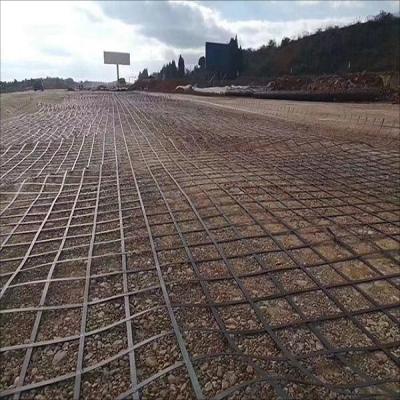1. Reinforcement principle
- Enhance soil stability
- The tensile force of the steel-plastic geogrid is borne by the high-strength steel wire woven with warp and weft, which produces extremely high tensile modulus under low strain capacity. The synergistic effect of the longitudinal and transverse ribs can give full play to the locking effect of the grid on the soil, effectively prevent the lateral displacement of the soil and enhance the overall stability of the subgrade. It’s like adding a solid frame to the loose soil, so that the soil is not easy to deform.
- Improved load carrying capacity
- The warp and weft of the steel wires of the longitudinal and transverse ribs are woven into a net, and the outer wrapping layer is formed at one time. The steel wire and the outer wrapping layer can coordinate, and the failure elongation is very low (no more than 3%). The main stress unit is steel wire, and the creep is extremely low. Such characteristics enable the steel-plastic geogrid to bear larger tensile force in the subgrade, share the pressure of vehicles and other loads on the subgrade, thus improving the bearing capacity of the subgrade, just like adding many strong support points in the weak subgrade 。
- Increase the friction coefficient
- Through the treatment of the plastic surface in the production process, rough patterns are pressed, which enhances the roughness of the grid surface and improves the friction coefficient between the steel-plastic grid and the soil. This helps to better bond the grid with the soil, allowing the grid to play a more effective reinforcement role and prevent the subgrade from slipping under load 。
2. Specific application in reinforcing and widening subgrade
- Application of the junction of new and old subgrade
- Reduce uneven settlement :In the old road widening and reconstruction project, uneven settlement is easy to occur at the junction of new and old roadbed. Steel-plastic geogrid has strong tensile strength, laid between new and old roadbed, can improve the stability of roadbed at the overlap of new and old roads, effectively reduce or prevent the crack phenomenon caused by uneven settlement of roadbed overlap of new and old roads, make the new and old roads form a whole, ensure the stability of roadbed 。
- Enhanced connectivity :It can better connect the soil of the new subgrade with the soil of the old subgrade, so that the new and old subgrades can bear the force together. For example, when the old road is widened, the steel-plastic geogrid is laid at the junction level of the new and old roadbed, and its longitudinal and horizontal ribs can be tightly locked with the soil on both sides, so as to improve the overall bearing capacity and stability of the new and old roadbed, and prevent problems such as cracks or collapses during subsequent use 。
- Widening part of subgrade reinforcement
- Improved shear strength :For widened subgrade, steel-plastic geogrid can enhance the shear strength of subgrade soil. When the subgrade is subjected to horizontal forces such as vehicle driving, the grille can resist this horizontal shear force and prevent the shear failure of the subgrade soil. For example, in highway widening projects, laying steel-plastic geogrid in widened subgrade fill can significantly improve the shear resistance of subgrade and ensure the safety and stability of widened subgrade structure 。
- Prevention of lateral displacement :Because of the good tensile performance of steel-plastic geogrid, it can effectively restrain the lateral deformation of subgrade fill. During the construction process of widening subgrade, the filling soil may be displaced to the outside under the action of self-weight and external load. Steel-plastic geogrid can provide lateral restraint, keep the shape and size of subgrade, and avoid the collapse of subgrade slope。
Post time: Feb-12-2025




